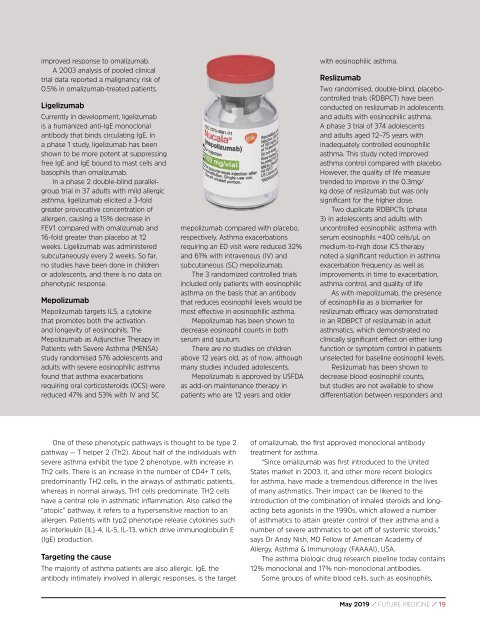may edition file
Create successful ePaper yourself
Turn your PDF publications into a flip-book with our unique Google optimized e-Paper software.
improved response to omalizumab.<br />
A 2003 analysis of pooled clinical<br />
trial data reported a malignancy risk of<br />
0.5% in omalizumab-treated patients.<br />
Ligelizumab<br />
Currently in development, ligelizumab<br />
is a humanized anti-IgE monoclonal<br />
antibody that binds circulating IgE. In<br />
a phase 1 study, ligelizumab has been<br />
shown to be more potent at suppressing<br />
free IgE and IgE bound to mast cells and<br />
basophils than omalizumab.<br />
In a phase 2 double-blind parallelgroup<br />
trial in 37 adults with mild allergic<br />
asthma, ligelizumab elicited a 3-fold<br />
greater provocative concentration of<br />
allergen, causing a 15% decrease in<br />
FEV1 compared with omalizumab and<br />
16-fold greater than placebo at 12<br />
weeks. Ligelizumab was administered<br />
subcutaneously every 2 weeks. So far,<br />
no studies have been done in children<br />
or adolescents, and there is no data on<br />
phenotypic response.<br />
Mepolizumab<br />
Mepolizumab targets IL5, a cytokine<br />
that promotes both the activation<br />
and longevity of eosinophils. The<br />
Mepolizumab as Adjunctive Therapy in<br />
Patients with Severe Asthma (MENSA)<br />
study randomised 576 adolescents and<br />
adults with severe eosinophilic asthma<br />
found that asthma exacerbations<br />
requiring oral corticosteroids (OCS) were<br />
reduced 47% and 53% with IV and SC<br />
mepolizumab compared with placebo,<br />
respectively. Asthma exacerbations<br />
requiring an ED visit were reduced 32%<br />
and 61% with intravenous (IV) and<br />
subcutaneous (SC) mepolizumab.<br />
The 3 randomized controlled trials<br />
included only patients with eosinophilic<br />
asthma on the basis that an antibody<br />
that reduces eosinophil levels would be<br />
most effective in eosinophilic asthma.<br />
Mepolizumab has been shown to<br />
decrease eosinophil counts in both<br />
serum and sputum.<br />
There are no studies on children<br />
above 12 years old, as of now, although<br />
many studies included adolescents.<br />
Mepolizumab is approved by USFDA<br />
as add-on maintenance therapy in<br />
patients who are 12 years and older<br />
with eosinophilic asthma.<br />
Reslizumab<br />
Two randomised, double-blind, placebocontrolled<br />
trials (RDBPCT) have been<br />
conducted on reslizumab in adolescents<br />
and adults with eosinophilic asthma.<br />
A phase 3 trial of 374 adolescents<br />
and adults aged 12–75 years with<br />
inadequately controlled eosinophilic<br />
asthma. This study noted improved<br />
asthma control compared with placebo.<br />
However, the quality of life measure<br />
trended to improve in the 0.3mg/<br />
kg dose of reslizumab but was only<br />
significant for the higher dose.<br />
Two duplicate RDBPCTs (phase<br />
3) in adolescents and adults with<br />
uncontrolled eosinophilic asthma with<br />
serum eosinophils =400 cells/µL on<br />
medium-to-high dose ICS therapy<br />
noted a significant reduction in asthma<br />
exacerbation frequency as well as<br />
improvements in time to exacerbation,<br />
asthma control, and quality of life<br />
As with mepolizumab, the presence<br />
of eosinophilia as a biomarker for<br />
reslizumab efficacy was demonstrated<br />
in an RDBPCT of reslizumab in adult<br />
asthmatics, which demonstrated no<br />
clinically significant effect on either lung<br />
function or symptom control in patients<br />
unselected for baseline eosinophil levels.<br />
Reslizumab has been shown to<br />
decrease blood eosinophil counts,<br />
but studies are not available to show<br />
differentiation between responders and<br />
One of these phenotypic pathways is thought to be type 2<br />
pathway — T helper 2 (Th2). About half of the individuals with<br />
severe asthma exhibit the type 2 phenotype, with increase in<br />
Th2 cells. There is an increase in the number of CD4+ T cells,<br />
predominantly TH2 cells, in the airways of asthmatic patients,<br />
whereas in normal airways, TH1 cells predominate. TH2 cells<br />
have a central role in asthmatic inflammation. Also called the<br />
“atopic” pathway, it refers to a hypersensitive reaction to an<br />
allergen. Patients with typ2 phenotype release cytokines such<br />
as interleukin [IL]-4, IL-5, IL-13, which drive immunoglobulin E<br />
(IgE) production.<br />
Targeting the cause<br />
The majority of asthma patients are also allergic. IgE, the<br />
antibody intimately involved in allergic responses, is the target<br />
of omalizumab, the first approved monoclonal antibody<br />
treatment for asthma.<br />
“Since omalizumab was first introduced to the United<br />
States market in 2003, it, and other more recent biologics<br />
for asthma, have made a tremendous difference in the lives<br />
of many asthmatics. Their impact can be likened to the<br />
introduction of the combination of inhaled steroids and longacting<br />
beta agonists in the 1990s, which allowed a number<br />
of asthmatics to attain greater control of their asthma and a<br />
number of severe asthmatics to get off of systemic steroids,”<br />
says Dr Andy Nish, MD Fellow of American Academy of<br />
Allergy, Asthma & Immunology (FAAAAI), USA.<br />
The asthma biologic drug research pipeline today contains<br />
12% monoclonal and 17% non-monoclonal antibodies.<br />
Some groups of white blood cells, such as eosinophils,<br />
May 2019 / FUTURE MEDICINE / 19


















